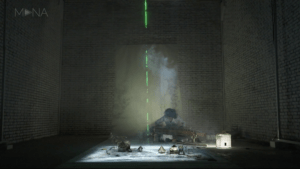A.
By introducing interactive projects and gradually experiencing new comprehension of interaction, Ernest Edmonds illustrated his definition and classification of interaction in the article “Art, Interaction and Engagement”. Before, I only know how to define degrees of Interactivity based on “The Art of Interactive Design” by Crawford. However, Edmonds inspires me to think more about different types of interactions. Apart from the approaches of interaction, “direct, facilitated, and ambient”, there are four dynamic-interactive categories depending on how the projects give feedback. I think he puts forward an interesting idea about ‘influence’ rather than ‘interaction’. Maybe it is because I did not expose to many interactive projects, I never took the responding time into consideration. This idea reminded me of the ‘count’ and ‘delay’ codes. If I make use of these two in the final project perhaps I can also create interactions, not about instant response and attraction, but slow cumulative development.
B.
I also searched for many interactive art projects online.
This first one is SYMBIOSIS —— Human&Natrue by ShenMao. The artist plays Guzheng not only to show her emotion and create rhythms but also to connect to the laser, which represents rain, and gas to show the relationship between humans and nature. I found it interesting because the music, scene, emotions, and ideas all combined together by a seemingly simple step, playing with the instrument. The artist can make use of the Guzheng to start the device, deliver music, and change the frequency of the laser. In my opinion, it is multifunctional and interactive. I have not thought about we can connect external objects with the microcontroller. This is a successful project since the device varies when the user has different actions and the experience effect is amazing. For the final project, I can focus on the harmony between sound and visuals to make it more appealing.

The second project is SPIRALALALA – singing architecture by panGenerator. Users can sing a piece of rhythm to a ball and throw the bowl to the tracks installed on the stairs to hear the sound change. I like this project because the designers take advantage of the space and gravity to show the falling of the ball, which emphasizes the visuals through sounds. Therefore, when the user throws the ball, he or she can not only see it falling with the light of the stairs change but also ‘feel’ the falling by hearing the sound’s echo and the space effect. The record sound function also increases the change and interaction. Over, I think it is successful because it makes use of all the factors we can see in the videos, which is minimalist but interesting enough. The subtraction is important from my perspective to delete all the extra things and make the scene simple and functional. This is what I can try to do in the final.

C.
According to the group project and midterm project, I think a successful interaction experience has many essential points. Besides the high level of interaction I keep mentioned in the past blog, the device needs to function logically and not be too complex for the users to explore. I pretty much agree with the article “Making Interactive Art: Set the Stage, Then Shut Up and Listen” by Tom Igoe that the interaction project is like a performance that invites users to participate, while the designers only stay besides observing. For my midterm project, I did not use any instructions in the beginning because I do not want to invade the interaction between the users and the project. They can figure it out themselves. When the user knocks on the door, the device needs to have some proper response to show the door is one part we can interact with; otherwise, the user may just leave and lack interest. Therefore, if the project is not extremely attractive, I can not design a too difficult start-up program or step because users do not have the patience to keep trying. The examples I chose above also have no instructions besides the project. Everyone can try to sing to a ball or play with the Guzheng and see how the device interacts.
Leave a Reply